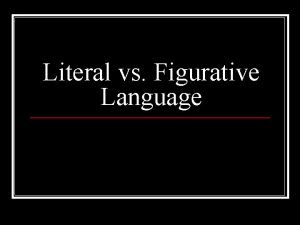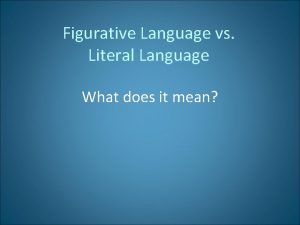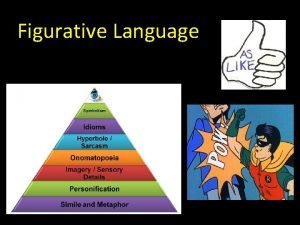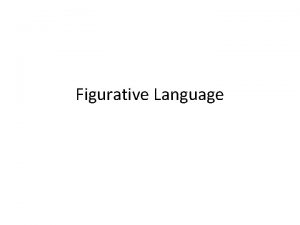UNDERSTANDING FIGURATIVE LANGUAGE Understanding Figurative Language Introduction A


























- Slides: 26

• UNDERSTANDING FIGURATIVE LANGUAGE

Understanding Figurative Language • Introduction • A. John 16: 25, “These things I have spoken to you in figurative language…” • B. Why use figurative language? To emphasize, to enhance, to make it easier to remember the teaching.

Understanding Figurative Language C. How can we know when it is figurative language? (1) If the text indicates that it is; (2) if the sense of the context indicates that it is; (3) if the literal meaning indicates an impossibility; (4) if the literal meaning contradicts another text; and (5) above all, by the use of common sense. • D. We use figurative language in our everyday speech: “the crops suffer”; “he has a hard heart”; “she has an iron will, ” etc. •

Understanding Figurative Language • E. If we say “like” or “as” we are using figurative language. • If we exaggerate we use figurative language (this is called hyperbole). • If we ask a rhetorical question ( a question asked for effect, no answer expected) we use figurative language.

Understanding Figurative Language • I. PARABLE, “A short, simple story, usually of an occurrence of a familiar kind, from which a moral or religious lesson may be drawn. ” • A. Mark 4: 34, “But without a parable He did not speak to them. And when they were alone, He explained all things to His disciples. ”

Understanding Figurative Language B. The best known parables are probably the sower, the good Samaritan and the prodigal son. These well illustrate how parables help us to learn and remember certain truths. • C. The parables are not about specific people. Therefore, the account of the rich man and Lazarus (Luke 16: 19 -31) is not a parable because it talks about a specific man by the name of Lazarus. •

Understanding Figurative Language • II. SIMILE. • A. This is the most common form of figurative language and simply means a “likeness. ” We say something is “like” or “as” and make a comparison. • B. Matt. 9: 36, “when He saw the multitude, He was moved with compassion for them, because they were weary and scattered, like sheep having no shepherd. ”

Understanding Figurative Language C. Matt. 23: 27, “you are like whitewashed tombs. ” • D. 1 Pet. 1: 24, “all flesh is as grass. ” • E. The similitude is a longer form of a simile. Example: Matt. 7: 24 -27, the two builders. •

Understanding Figurative Language • III. METONYMY – “use of the name of one thing for that of another associated with or suggested by it (Ex. : ‘the White House’ for ‘the President’)”. • A. The person acting is put for the thing done (or the blessings received from him). This is the case in many texts referring to the Spirit. Acts 2: 38, “gift of the Holy Spirit” (the blessings bestowed by Him)

Understanding Figurative Language • Stated another way: Putting the “Cause” for the “Effect” • … 1 Cor. 14: 12, “you are zealous for spiritual gifts (Greek says “spirits”—that is, spiritual powers, gifts, revelations) • … Eph. 5: 18, “be filled with the Spirit” (the effects or fruit of the Spirit, Gal. 5: 22, 23). .

Understanding Figurative Language • B. The container for the contents. • Deut. 28: 5, “Blessed shall be your basket and your kneading trough” (referring to their contents) … • Luke 22: 17, “Then He took the cup, and gave thanks, and said, ‘Take this and divide it among yourselves” (obviously the contents and not the container).

Understanding Figurative Language • C. Sin is put for the offering for sins. • Hosea 4: 8, “they eat up the sin (that is, the sin offering) of my people” … • 2 Cor. 5: 21, “He has made Him to be sin (that is, a sin offering) for us. ”

Understanding Figurative Language • D. Faith is put for the thing believed. Acts 6: 7, “a great company of the priests were obedient to the faith” … Jude 3, “contend for the faith” • E. Bed is put for the sexual relation. Heb. 13: 4, “Marriage is honorable among all, and the bed undefiled. ”

Understanding Figurative Language • IV. SYNECDOCHE – “a figure of speech in which a part is used for the whole. ” This is one of the major stumbling blocks for Bible students. • A. Baptism is put for the ministry. Acts 1: 22, “beginning from the baptism of John” (that is, his ministry) … • B. Break bread is put for partaking of the Lord’s Supper. Acts 20: 7, “on the first day of the week when the disciples came together to break bread”.

Understanding Figurative Language • C. Faith is put for obedience. Jn. 3: 16, “For God so loved … that whoever believes in Him …” • Hearing is put for obedience, Jn. 5: 25, “those who hear will live. ” Faith only? Then “hear only” saves. • Repentance is put for obedience, Acts 11: 18, “God has granted to the Gentiles repentance to life” • Confession is put for obedience, Rom. 10: 10, “confession is made unto salvation” • Baptism is put for obedience, 1 Pet. 3: 21, “baptism now saves you” …

Understanding Figurative Language • D. House is put for family. Acts 10: 2, Cornelius “feared God with all his house. ” • E. Table is put for the good things on it. Ps. 23: 5, “You prepare a table before me. ” Also 1 Cor. 10: 21, “the Lord’s table” is put for the Lord’s Supper. • F. Altar is put for the sacrifice. Heb. 13: 10, “we have an altar from which those who serve the tabernacle have no right to eat. ” What is eaten is not the altar but the sacrifice.

Understanding Figurative Language • V. METAPHOR – “a figure of speech containing an implied comparison in which a word or phrase ordinarily and primarily used of one thing is applied to another. ” • A. Matt. 26: 26 -28, “Jesus took bread, blessed and broke it, and gave it to the disciples and said, ‘Take, eat; this is my body. ’ Then He took the cup and gave thanks and gave it to them, saying, ‘Drink from it, all of you. For this is my blood of the New Covenant. ”

Understanding Figurative Language • The verb “is” obviously means “represents” because when Jesus made this statement He was alive in His physical body. • This figurative language has been grossly abused by insisting that it is literal, that the bread and cup when blessed become the literal body and blood of Jesus.

Understanding Figurative Language • B. The church called “the body of Christ” (Eph. 1: 22, 23). • Or “the kingdom of heaven” (Matt. 16: 18, 19); • Or the “temple of God” (1 Cor. 3: 16); • Or “the house (family) of God” (1 Tim. 3: 15); • These are well known metaphors. No problem.

Understanding Figurative Language • VI. ELLIPSIS – “The omission of a word or words in a sentence” which is explained by the context. • In writing we indicate an ellipsis by using three periods (…). • A. 1 Cor. 15: 29, “Otherwise, what will they do who are baptized for the dead, if the dead do not rise at all? Why then are they baptized for the dead? ”

Understanding Figurative Language • Here Paul shows the inconsistency of those who were teaching that there is no resurrection (1 Cor. 15: 12) and yet they continued to practice baptism. • This figure is abused by Mormon theology in that it is used to authorize vicarious baptism; that is, a person can be baptized for a dead relative who failed to be baptized before he/she died. • This is an example of making figurative language contradict a host of plain passages.

Understanding Figurative Language • The word “for” (huper) is also in v. 3 of the same chapter and obviously means “with regard to. ” • In other texts (Rom. 9: 27; 2 Cor. 12: 8) it is translated “concerning. ” It has that meaning here. • A person is baptized “for” or “with regard to” or “concerning” the dead who will be raised. • So why be baptized if there is no resurrection?

Understanding Figurative Language • Conclusion. A. We should not stumble over figurative language. As we speak or write we are not thinking “grammar, ” but like it or not we are using it -- correctly or incorrectly, but we are using it. • B. The Bible definitely uses figurative language and also other forms of expression that we are not accustomed to. • C. So we need to study! We need to do whatever is necessary to understand the will of God so that we can obey it and be saved.

Understanding Figurative Language

Understanding Figurative Language

Understanding Figurative Language
 Meter figurative language
Meter figurative language Introduction to poetry poem
Introduction to poetry poem Literal language
Literal language What is figurative
What is figurative Literal vs figurative examples
Literal vs figurative examples Grant always turns in his homework
Grant always turns in his homework Figurative vs literal
Figurative vs literal What's the difference between an idiom and a hyperbole
What's the difference between an idiom and a hyperbole Is figurative language a language feature
Is figurative language a language feature Understanding assembly language
Understanding assembly language Introduction paragraph structure
Introduction paragraph structure Repetition in night by elie wiesel
Repetition in night by elie wiesel Winter personifications
Winter personifications Game language
Game language Figurative language
Figurative language Questions about figurative language
Questions about figurative language Trashketball directions
Trashketball directions Is tone figurative language
Is tone figurative language The world is too much with us imagery
The world is too much with us imagery Figurative language in the song what a wonderful world
Figurative language in the song what a wonderful world The unknown citizen literary devices
The unknown citizen literary devices Little lamb figurative language
Little lamb figurative language What does the tell tale heart mean
What does the tell tale heart mean Whats a simile
Whats a simile The rime of the ancient mariner part 1 figures of speech
The rime of the ancient mariner part 1 figures of speech Story of my life figurative language
Story of my life figurative language Alliteration in song
Alliteration in song















































